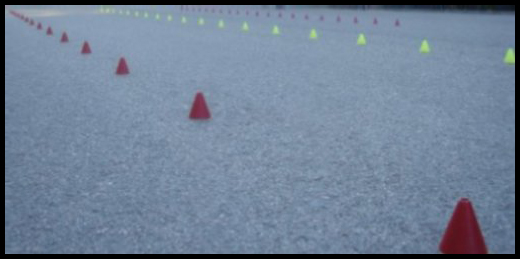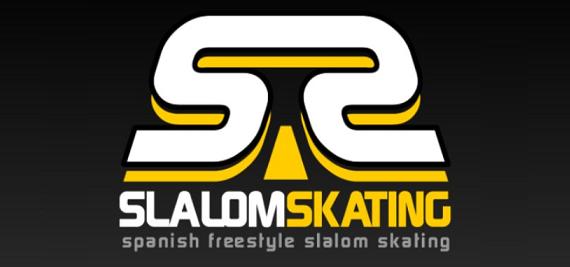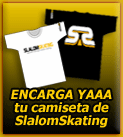When to start with slalom
There is no age limit!! Any skater able to move without falling too much :) may start with freestyle slalom. Freestyle slalom facilitates the development of the skater’s equilibrium and makes his/her ability to control improve much faster.
How to create a place to practice
The best surface is fine cement or whatever smooth floor that is not slippery. Identify a level place to paint 20 marks on the floor in a straight line for placing the cones. (Soft rubber cones are recommended, not hard plastic, to avoid getting hurt when falling.) It is best to use a rope to ensure the straightness of the line, a tape measurer and a spray (or any type of marker). The distance between the cones is constant, and for training and competitions around the world is: 50, 80 and 120cm. (The latter is for 14 cones instead of 20.) 120cm may be useful to learn the first figures, but we recommend using 80cm, the most frequently used, as soon as possible. The cones are 50cm apart at an advanced level, when most of the classic figures within 80cm spacing is already learned.


How to start
The simplest tricks for beginning free-style slalom are: fish, cross y snake, followed by other forward tricks. On the SlalomSkating trick list we have assigned a level of difficulty from 1 to 5 to each trick. During the first stage, we advise learning all the level 1 and 2 tricks. The backwards tricks are not necessarily more difficult than the forward tricks, but require knowing how to skate backwards fluently before practicing them.
To find desired tricks of various levels or characteristics, you can use the handy search engine that we have created to facilitate the query of our database of tricks.
A general rule in the learning of slalom is to first practice the movements without cones. This allows you to develop the technique without the cones and is more comfortable. Our priority must be the movement of the skates and our body, and not the cones. Once we have learned the movements, we will then be able to focus our attention on not hitting the cones.
Another very important rule is to practice all the tricks on both sides (or with each leg). This creates symmetry with the tricks and is fundamental to developing freedom of movement between the cones, in addition to being very good for our body.
When will we be able to say that we have learned a trick? Generally, if we are able to correctly repeat the movements through 20 cones without touching any, we can consider the trick to be learned.
How to tune the style
After we know how to do a trick, we have to practice it to execute it more smoothly. Some will improve more easily than others. The important point is to know that with practice anyone can not only accomplish how to do a trick, but also ensure that it is graceful and smooth.
It is very important to look at the movements of the arms and not the legs only. Sudden or awkward movements of the arms can look like an unattractive round of freestyle, even though the tricks are done correctly with the legs.
How to be a freestyler
To learn tricks created by others is a useful exercise, but it is much more important to be creative and to try to innovate. This is translated directly in the form of connecting tricks, (combinations). Something fundamental in a freestyler is the versatility at the time of connecting tricks.
The style is the form with which the skater moves.Normally it’s an innate characteristic, (more or less good). It always can be improved by paying attention to aspects like the movement of the arms, balance of the body, etc.











